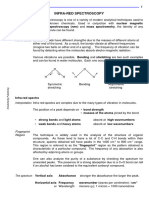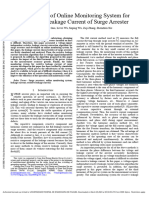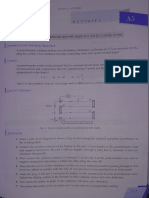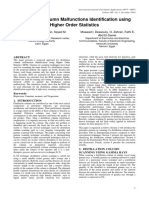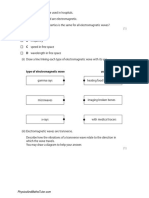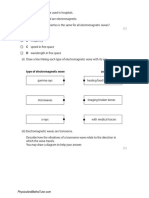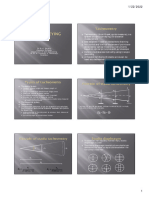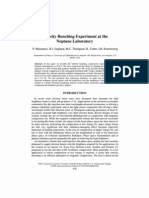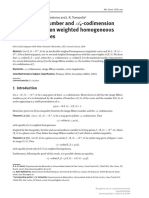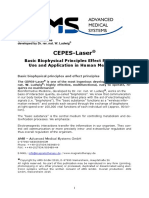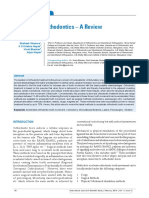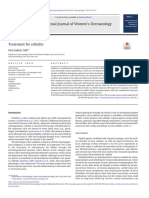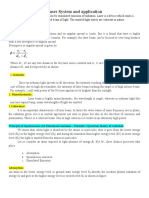Wan Ser 1990
Wan Ser 1990
Uploaded by
danie.arti01Copyright:
Available Formats
Wan Ser 1990
Wan Ser 1990
Uploaded by
danie.arti01Copyright
Available Formats
Share this document
Did you find this document useful?
Is this content inappropriate?
Copyright:
Available Formats
Wan Ser 1990
Wan Ser 1990
Uploaded by
danie.arti01Copyright:
Available Formats
Interferometric
Interferometric Measurement
Measurement and
and Calibration
Calibration of
of DC
DC Strain
Strain of a Fiber
Fiber Optic
Optic Embedded
Embedded
Graphite Epoxy
Epoxy Composite
Composite Panel
Keith H. Wanser
Department of
of Physics, California State University Fullerton
Fullerton, CA 92634
and
Tom D. Wang
Dynamics Technology Inc., Torrance, CA 90503
ABSTRACT
strain produced by transverse deflection of a fiber optic embedded graphite/
Measurements of DC strain
bismaleimide composite panel in cantilever geometry were made using a Mach Zehnder interferometer and
active homodyne demodulation technique. The Themeasured
measuredstrain
strain ranged
rangedfrom
fromananaverage
averagelongitudinal
longitudinalstrain
strain
10'4 to 6.6 x 10-7,
of 2.0 x 10-4 10"7 , corresponding to a maximum transverse deflection
deflection of of0.3
0.3inches
inches(3(3%) and aa
%) and
minimum transverse deflection of 0.001 inches respectively. We We find
findthat
thatthe
the strain
strain optic
optic coefficient
coefficient of
ofthe
the
embedded fiber
embedded fiber ranges
ranges from
from 30%30% to 40%40% less than the value for uniaxial
uniaxial strain.
strain. In addition,
addition, these
these
measurements reveal hysteresis and and or
or creep
creep during
during the
the loading
loading and
and unloading
unloading cycle
cycleofofthe
thecomposite.
composite.
Experiments were performed to determine sources sources of
of DC drift, and the main sources of of DC drift identified.
Calibration
Calibration ofof the
the results
results isis discussed
discussed as as well
well as
as future
future modifications
modifications that
that will
will permit
permit four
four orders
orders of
of
magnitude increase in tracking range, greatly improved interferometer stability,
magnitude stability, and elimination
elimination of the
the
effects of piezoelectric hysteresis on on the
the measurement
measurement ofof strain.
strain.
2. INTRODUCTION
2. INTRODUCTION
The purpose of this paper is to to present
present results of of DC strain
strain measurements
measurements performed on on aa fiber
fiber
optic embedded graphite epoxy composite panel The fiber
panel. The fiber optic
optic embedded
embedded composite
composite panel,
panel, fabricated
fabricated
during a Phase ISBIR
I SBIR effort
effortl,1, was
was connected
connected into
into aa fiber optic Mach Zehnder testbed interferometer under under
development by
development by Dynamics
Dynamics Technology
Technology Inc. This interferometer
Inc. This interferometer had had greatly
greatly extended
extended tracking
tracking range,
range,
improved optical
improved optical feedback electronics,
electronics, and and a more stable laser than the Phase I interferometer,
interferometer, which
which
allowed
allowed measurements
measurements of of DC
DC strain
strain to
to be
be made. Consistent with the objectives of ease of implementation
made. Consistent implementation
and
and low
low cost,
cost, the interferometer testbed, shown in Fig. 1, 1, utilized
utilized the
the active
active homodyne
homodyne demodulation
demodulation
method2'3, piezoelectric
method2,3, piezoelectric ceramic (PZT)(PZT) feedback
feedback element,
element, andand aacompact,
compact,non non-actively stabilizedHe
-actively stabilized He-Ne
-Ne
This approach
laser. This approach has
hasthe
theadvantages
advantagesof ofnot
notrequiring
requiring careful
careful path
path length
length matching
matching of
ofthe
the two
two arms
arms of
of
the interferometer due to the long coherence length of the gas laser, as well as providing a linear measure
of the strain induced optical phase shift and a wide wide dynamic range associated with closed loop loop phase
nulling. An
nulling. An additional
additional advantage
advantage of of the
the closed loop approach
approach is: the strain
is: the strain scale
scale factor
factor depends
depends only on
the feedback PZT conversion gain factor, independent of polarization fading, amplifier gains, and laser
intensity.
3. COMPOSITE SENSOR
3. COMPOSITE SENSOR DESIGN
DESIGN AND
AND FABRICATION
FABRICATION
The flexibility of optical fiber allows for a large variety of configurations for distributed strain
strain
measurements. By
measurements. By appropriate
appropriate choice
choice of
of fiber
fiber routing,
routing, one may extract linear strain,
strain, bending, torsion,
torsion,
differential strain, or combinations of these. Similarly,
Similarly, by
by concentrating
concentrating more
more fiber
fiberininareas
areasof
ofparticular
particular
(e. g. vibrational nodes or edges), one may amplify the contribution from these areas to the total
interest (e. total
integrated strain output.
SPIE Vol. 1170
SPIE Vol. 1170 Fiber
FiberOptic
OpticSmart
SmartStructures
Structures and
andSk/ns
SkinsIIII(1989)
(1989)// 405
Downloaded From: http://proceedings.spiedigitallibrary.org/ on 09/24/2015 Terms of Use: http://spiedigitallibrary.org/ss/TermsOfUse.aspx
Composite
Transducer Photodiode
Pre-amp
Pre -amp
Difference
Fiber Fiber
Amp
HeNe Laser Coupler
4° Coupler
4411.1*
Zehnder fiber
Mach Zehnder
Fig. 1. Mach interferometer testbed with active homodyne
optic interferometer
fiber optic
demodulation, used for fiber optic embedded composite panel strain measurements.
scope of the
Because of the limited scope
Because Phase II SBIR
the Phase SBIR and desire to
the desire
and the conceptual
demonstrate conceptual
to demonstrate
feasibility and consistency with readily obtainable theoretical predictions,
obtainable theoretical relativelysimple
predictions, aa relatively fiber/structural
simplefiber /structural
configuration was chosen, consisting of a rectangular beam with the embedded
with the uniformly from
embedded fiber offset uniformly from
the axis of symmetry. The dimensions
symmetry. The dimensions of were 12
beam were
the beam
ofthe 12x3x0.11
x 3 x 0.11 inches, and aa cantilever
inches, and cantilever length of
length of
inches was
10 inches
10 used in
was used all measurements
in all reported here.
measurements reported here. This shown in
configuration, shown
This configuration, 2, was
Fig. 2,
in Fig. made to
was made to
avoid having any fiber protrude out from the free end of the composite, since
of the loose fiber
since loose in the
fiber in vibration
the vibration
tests would add unnecessary noise to the measurements.
The fiber configuration used in this work contrasts with the one by Butter
used by
one used Butter and Hocker4, who
and Hocker4,
cemented two
cemented two fibers in grooves
fibers in the top
grooves to the bottom of
top and bottom of a cantilever.
cantilever. The fibers in
The fibers configuration
theirconfiguration
intheir
fiber was
so that one fiber
arranged so
looped out of the end of the cantilever, and were arranged always in
was always compression and
in compression and
the cantilever was
when the
extension when
the other in extension was deflected transverselyin
deflected transversely either direction.
ineither direction. The two fibers
attached to
attached to the opposite arms
were in opposite
the cantilever were optical phase
interferometer so that the optical
arms of the interferometer shifts
phase shifts
extension added
produced by the compression and extension rather than
added rather than subtracted.
subtracted. The configuration in that work
is not suitable for investigating differences between compression and elongation due to hysteresis and or
creep effects;
creep effects; however, it may be an configuration for
interesting configuration
an interesting diagnostic work
future diagnostic
for future two
utilizing two
work utilizing
interferometers for simultaneous measurement of of extension and compression.
fabrication of
The following procedure was used in the fabrication test specimens.
our test
of our Twenty plies
specimens. Twenty 640--
of 640
plies of
prepreg were
graphite /epoxyprepreg
600/5245C graphite/epoxy were cut [O4/90]}s2
cut and laid up in the prescribed [04/90 layup. After the 18th
s2 layup.
lain, a length of optical fiber was cut and laid on the ply in the configuration shown in Fig. 3. The
ply was lain, The
plies were
two plies
remaining two applied. Pigtails approximately one meter in length were left on the optical
then applied.
were then optical
facilitate splicing into the interferometer.
fiber to facilitate interferometer. The specimen was
The specimen cured in
then cured
was then programmable hot
in aaprogrammable hot
using the
press using
press suggested cure
manufacturer's suggested
the manufacturer's cure cycle.
cycle. A 100 psi was
A pressure of 100 throughout the
applied throughout
was applied
cycle. The temperature
cycle. The temperature was at 2°
raised at
was raised 2° FF/min. 350°FFand
to 350°
/min. to heldfor
andheld hours. Finally, the temperature
for22hours. temperature
decreased at
was decreased
was 5° F/min.
at 5° 90°F.F. The
F /min.toto90° specimen was
The specimen removed and
then removed
was then and cut diamond
cut to size with a diamond
impregnated saw.
4. EXPERIMENTAL
4. EXPERIMENTAL TESTING
TESTING AND
AND RESULTS
RESULTS
For the measurements reported here, the composite panel was anchored at one end and deflected
panel was
transversely atat the
transversely other end
the other end using micrometer driven
using aa micrometer stage,asasshown
translationstage,
driventranslation The
Fig.4.4. The
shownininFig.
resulting integrated longitudinal strain of the embedded optical fiber was determined by measuring the PZT PZT
feedback voltage,
feedback produced by
¿V f, produced
voltage, AVf, by the transverse deflection.
the transverse deflection. For closed loop operation of the active
Vol. 1170
SPIEVol.
406 //SPIE 1170Fiber Optic Smart
Fiber Optic andSkins
Structuresand
Smart Structures (1989)
Skins IIII (1989)
Downloaded From: http://proceedings.spiedigitallibrary.org/ on 09/24/2015 Terms of Use: http://spiedigitallibrary.org/ss/TermsOfUse.aspx
Cantilever Length
10.0"
10.0"
0.50"
CL
0.11"
3.0" 1.5"
3.0"-
3.0"
12.0"
(Not to Scale)
Fig.
Fig. 3, The composite
3. The composite panel
panel with
with embedded
embedded
Fig.
Fig. 2 Top view and layout of optical fiber optical fiber contains twenty plies. The optical
plies. The optical
embedded composite panel. fiber is laid between the 8th and 9th ply up
from the center line (CL).
homodyne feedback system, the length change, AL, of the optical fiber is determined by the relationship,
Kf
K
AL = AVf
f OVf (1)
A(|)/AL
0O /AL
where Kf is the feedback PZT PZT conversion
conversion gain,
gain, measured
measured to bebe 17.26
17.26 radians
radians/volt,
/volt, and
and we
we have
have used
used aa
strain-optic
strain -optic coefficient of
of 0O
Ac()/AL
/AL == 1.13
1.13 x 107 radians/meter,
radians /meter, determined as follows.
follows.
For the case of
of uniaxial
uniaxial strain,
strain, the
the optical
optical phase
phase change
change AO
Ac)) per unit elongation of
of the fiber AL is
is
given óy5,6
given by5'6
{i- 2
2
At _27En
A T ^
ß)p12- ap11J) (2)
s \.2f i. L
AL ñX z
0
Where
Where n is the fiber (effective)
(effective) refractive index, X0 2t0 the
the vacuum
vacuum wavelength,
wavelength, a6 the Poisson ratio ratio of the
the
fiber, and pn and pi2 are the photoelastic
fiber, and pii and p12 are the photoelastic constants for the fiber. Taking the following values
fiber. Taking the following values of the of the
parameters representative ofof fused
fused silica7-9
silica7'9 and a He-Ne laser
He -Ne lasersource; AO == 0.633
source; X0 0.633 xx 10'6
10-6m, m,nn == 1.457,
1.457,aß
pni = 0.121 and P12
= 0.17, NI pi2 = 0.270, we we obtain
obtain the
the value
valueAO/AL
A(|>/AL = 1.13
1.13 xx 107
107 rad
rad/m, which compares
/m, which compares
favorably with the measured value5 1.150 x 107
values for bare fiber of 1.150 107 rad/m. Details of
rad/m. Details ofthe
the strain
strain transfer
transfer from
from
composite panel
the composite panel to the optical fiber through the acrylate coating were ignored, and merit further
consideration, as the magnitude of the strain optic coefficient is affected by the details of the type of strain strain
and how it is applied to the optical fibers.
fiber5.
The theoretical longitudinal extension
extension of the
the fiber
fiber may
may be
be calculated
calculated as
as follows.
follows. The longitudinal
strain e(x)
e(x) at a distance x from the free end of the cantilever, when the free end transverse displacement
from its equilibrium position
position isis d,
d, isis given
givenby4,10
by4*10
3dax
E(x) (3)
L3
SPIE Vol.
SPIE Vol. 1170
1170Fiber
FiberOptic
OpticSmart
SmartStructures
Structuresand
andSkins
SkinsIIII(1989)
(1989)// 407
Downloaded From: http://proceedings.spiedigitallibrary.org/ on 09/24/2015 Terms of Use: http://spiedigitallibrary.org/ss/TermsOfUse.aspx
Thetotal
where a is the distance from the neutral axis and L is the cantilever length. The elongation in
total elongation fiber
the fiber
in the
can be found theoretically by integrating the strain from 0 to L and
and multiplying in order
by 22 in
multiplying by account for
to account
order to for
-passfiber
the 22-pass wrap in the composite element.
fiber wrap in the composite element. The result is
3da
AL =
L
A final formula for the length
length averaged
averaged strain, eaV) may
strain, eav, be obtained
may be eq. 4 by dividing by the total
obtained from eq.
fiber length 2L yielding
3da
(5)
Eav
2L2
Note
Note that eqs. 33-5 -5 are
are independent
independent of material
material properties
properties and depend only on on the geometry. The
the geometry.
parameters used in eqs. 4 and 5 for the
parameters panel fabricated in this work were L = 10
the panel in. and a = 0.044
10 in. 0.044 in.
Evaluating
Evaluating eq.eq. 55 for
for the cases of dd = 0.300
the cases and d = 0.001
0.300 and corresponding to
in., corresponding
0.001 in., maximum and
to the maximum and
minimum deflections observed in this study, average strain
study, we obtain the average 1.98 xx 10~4
of 1.98
strain values of 10-4 and 6.6 x
respectively. For d = 0.025 in., eq. 4 gives AL = 8.38
10-7respectively.
10"? m. This value of AL is shown on the
1(H> m.
8.38 xx 10-6
case.
graph in fig. 5 as the line labeled ideal case.
The amount of transverse deflection was determined by
was determined micrometer on
the micrometer
by the the translation
on the stage,
translation stage,
and was
and was incremented
incremented by by 0.025 inch in
0.025 inch in all measurements reported here.
measurements reported Measurements were
here. Measurements made of
were made
unloading the
loading and unloading panel in
the panel in the direction and
vertical direction
the vertical several times.
repeated several
and repeated times. The panel was then
turned over
over on
on its
its other side, measurements of loading
side, and measurements repeated. In
unloading the panel repeated.
and unloading
loading and this
In this
regard, one should note that the optical fiber
the optical embedded near
was embedded
fiber was near the top of
the top surface of
one surface
ofone of the panel. Thus
thepanel. Thus
measurements with
measurements with the
the fiber
fiber side compressed the
side facing down compressed the fiber when the panel was was loaded, and
loaded, and
measurements with the fiber side facing up caused the the fiber be elongated
to be
fiber to when the
elongated when the panel was loaded.
panel was loaded. In
cases, the
all cases, the panel
panel was started within
was started -0.002 inches of zero transverse deflection, with a slight contact
within -0.002 contact of
of
translation stage,
the translation stage. (0.001 in. was the resolution of the positioner, corresponding to
(0.001 in. to aa feedback voltage
feedback voltage
-0.15 volts,
of ~0.15 volts, which could easily be observed on DVM used
the DVM
on the measurements. Taking this
these measurements.
for these
used for this
value for
value for our
our minimum
minimum measured
measured average
average strain
strainwe obtainthe
weobtain value6.6
thevalue 10-7). The
6.6 xx 1Q~7). interferometer
The interferometer
feedback voltage
feedback voltage was
was then
then reset
reset to zero, the micrometer
micrometer screw advanced
advanced 0.0250.025 in. corresponding to
in. corresponding to
voltage measured.
panel, and the feedback voltage
loading the panel, measured. TheThe interferometer voltage was
feedback voltage
interferometer feedback then reset
was then
Fig. 4.^
Fig. 4. Photographic optic sensor testbed.
of the embedded fiber optic
Photographic overview of testbed. The fiber was
The fiber embedded in
was embedded in a
strip of
flat strip composite laminate
of composite which was deflected by the micrometer's translation stage during tests.
408 //SPIE
405 SPIE Vol.
Vol. 1170
1170 Fiber
Fiber Optic
Optic Smart
Smart Structures
Structures and
and Skins
Skins IIII (1989)
Downloaded From: http://proceedings.spiedigitallibrary.org/ on 09/24/2015 Terms of Use: http://spiedigitallibrary.org/ss/TermsOfUse.aspx
again to zero, the micrometer screw advanced and a reading taken, and this procedure repeated until the
translation
translation stage
stage ran
ran out
out of travel. The measurement
travel. The measurement procedure
procedure waswas then
then reversed (i. (i. e. the panel was was
unloaded),
unloaded), until
until the zero deflection
deflection position
position waswas returned
returned to.
to. Results for one set set of
of these
these measurements
measurements
are shown
shown inin Fig.
Fig. 5. Note the
5. Note the difference
difference inin the
the compression
compression vs. vs. elongation
elongation results,
results, this
this was
was observed
observed in
all sets of measurements. ItItisis interesting
interesting that
that the
the average
average length
length change
change produced
produced by by loading
loading the the panel in
one direction and compressing the fiber is very close to the length change produced produced by by unloading
unloading the the panel
and allowing the fiber to shorten
shorten from
from aa previous
previous extension
extension .. The
The same observation holds true for the
reverse case of loading the panel in the opposite direction, corresponding to elongating the fiber, and then then
unloading the panel from aa previous compression.
compression. InInboth bothcases,
cases,the
theobserved
observedlength
lengthchange
changeisis3030%-40%% -40%
less than the ideal length change, indicating incomplete strain strain transfer
transfer thru the
the acrylate
acrylate jacket
jacket to to the
the optical
optical
fiber, a result consistent with experience in other fiber sensor transducer applications (Note that the the use
use ofof
the hydrostatic strain instead of of the uniaxial
uniaxial result of of eq. 2 is completely
completely inappropriate,
inappropriate, as a§ itit would
would make
make
the data presented in fig. 5 larger than the ideal case by a factor of 2). In Inall
allcases,
cases,the
thezero
zeroposition
positionon on the
the
micrometer translation stage was reestablished within -0.003 -0.003 inches
inches by
by observing
observing the the feedback
feedbackvoltage, voltage,
showing that the positioner backlash was not the cause of of the
the observed
observed hysteresis
hysteresis/asymmetry.
/asymmetry. In In fact,
fact, the
the
voltage value increments were consistent when the positioner was reversed, indicating that the change in
direction of the positioner at the
direction the end
end point
point waswas not
not responsible
responsible forfor the
thedifference
difference ininelongation
elongation vs. vs.
compression results.
difference in
The difference in length
length change
change produced
produced when
when the
the fiber
fiber was
was being
being shortened
shortenedvs.
vs. lengthened
lengthenedcould
could
arise
arise from more than one
from more one source.
source. The following
following possibilities
possibilities require
require further
further investigation.
investigation. 1.)
Bidirectionality in the composite
Bidirectionality composite cantilever
cantilever properties.
properties. 2.)
2.) Hysteresis
Hysteresis and
and or
or creep
creep in
in the
the composite
composite
3.) Bidirectionality
material. 3.) Bidirectionality/hysteresis
/hysteresis ininthe
theembedded,
embedded, high
high temperature
temperature cured,
cured, acrylate
acrylate fiber
fiber coating.
coating.
Bidirectionality/hysteresis
4.) Bidirectionality /hysteresis in the ceramic feedback PZT. The The limited
limitedinvestigation
investigationpresented
presentedherehere did
did
determine which
not determine which of
ofthese
these possibilities
possibilities was responsible for the observed effect. Provisions to eliminate
effect. Provisions eliminate
possibilities 3 and 4 in future investigations are discussed below.
10
10
Ideal Case
Ideal Case
8
--O -4
4
NOi Mean Dev.
Std. Dey.
I 2H -a-
O
CO
---w -- Load (compression) 5.72 0.39
Unload (lengthen) 4.78 0.44
2 Load (elongation) 5.02 0.41
0)
Unload (shorten) 5.58 0.39
Ideal Case 8.38 NA
0
0.00 0.05 0.10 0.15 0.20 0.25 0.30
Transverse Deflection (Inches)
Fig.
Fig. 5. Measured length
5. Measured length change
change produced
produced byby successive
successive 0.025
0.025 in.
in. transverse
transverse deflections
deflections of
of the
the fiber
fiber
embedded
embedded composite
composite panel. Shown for
panel. Shown for comparison
comparison is the
the ideal cantilever length change computed from
eq. 4, as discussed in the text. The
The mean
mean and
and standard
standard deviation
deviation of
of each data set
set are also shown.
shown.
SPIE
SPIE Vol.
Vol 1170
1170 Fiber
Fiber Optic
OpticSmart
SmartStructures
Structuresand
andSkins
SkinsIIll(1989)
(1989)// 409
Downloaded From: http://proceedings.spiedigitallibrary.org/ on 09/24/2015 Terms of Use: http://spiedigitallibrary.org/ss/TermsOfUse.aspx
5.
5. LIMITATIONS,
LIMITATIONS, SOURCES
SOURCES OF DRIFT
DRIFT AND
AND FUTURE
FUTURE IMPROVEMENTS
IMPROVEMENTS
5.1
5.1 Interferometer Drift
Drift
The necessity for resetting the interferometer between successive transverse displacements waswas due
to DC drift of the PZT feedback voltage in between measurements. The two major sources of this
measurements. The two major sources of this drift drift
have been identified, and can be reduced by at least two orders of
of magnitude
magnitude in
in future
future interferometers,
interferometers, as
as
discussed below.
The He
He-Ne
-Ne laser
laser frequency
frequency drift with temperature, coupled with the large path
path length
length imbalance
imbalance in
in
the
the test
test interferometer
interferometer (~40
( -40 meters),
meters),causes
causesaa feedback
feedbackvoltage
voltagedrift. interferometer path
drift. The large interferometer path
mismatch
mismatch was
was mandated
mandated by by the
the existing
existing hardware
hardware that
that was
was borrowed
borrowed from
from another
another project. size of the
project. The size
feedback voltage drift
drift,, SVf,
SVf, associated with a drift in the laser frequency of 8f
Sf is
is given by
2nn (L, - L2)
5Vf
SVf =[
- l Sf (6)
cKr
cKf
(Li-L2)
where (Li -L2) isis the
the path
path length
length mismatch
mismatch between
between the the two
two arms
arms of the interferometer, c the free free space
space
velocity of light,
velocity light, and the other symbols as defined previously. previously. Using Using the
thevalues
values(L1 -L2) == 40
(Li-L2) 40 m,
m, nn ==
1.457, c = 3.00 x 108
1.457, 108 m/sec., and
and KfKf == 17.26
17.26 rad.
rad./volt
/volt we obtain the the value
value SVf
8Vf/5f
/Sf == 7.1
7.1 x 10-8
10'8 volts/Hz.
The laser frequency shift can be produced
produced by by aa change
change in in the
the laser
laser cavity
cavity length
length Lc,
Lc, due
due to
to small
small changes
changes in
in
the laser temperature. This This can
can be
be seen
seen by
by noting
noting that
that the
the wavenumber
wavenumber of ofthe
the mth
mth cavity
cavity mode
mode isis given
given by
by
-mn2nf-2n
__ mn (7)
m C
Lc
0
so that
that the
the frequency
frequency shift of the mode is
shift of
SL
6L
Sf = - (8)
(8)
o
Assigning an
an effective
effective linear
linear thermal
thermal expansion
expansion coefficient
coefficient a,
a, such that
8L
SL
L° =cc8T
=aST (9)
c
where 5T
ST is
is the
the temperature
temperature change of the laser tube, we obtain the laser frequency shift
shift with temperature
temperature
Sf==- - c a<x8T
8f ST (10)
o
Taking the conservative
conservativeestimate
estimatefor
forthe
theexpansion
expansioncoefficient
coefficientofof 10'6/°C
10-6 (Pyrexisis3.2
/ °C (Pyrex 3.2x x10-6
10'6/°C), and ñ,p
/ °C), and Xo
10'7 m, we obtain the
= 6.33 x 10-7 the value
value ofofSf
8f/8T
/ST = 4.7 x 108
108 Hz
Hz/°C.
/ °C. Combining
Combining eq. eq. 6 with eq. 10,10, we
obtain for the feedback voltage change with laser temperature fluctuation,
27tn(Lr
2nn L2 )
(Li- L2
8Vf
SVf== -- aST
ccST (11)
XoKf
X K
o f
410 //SPIE
SPIEVol
Vol.1170
1170Fiber
FiberOptic
OpticSmart
SmartStructures
Structuresand
andSkins
Skins IIII (1989)
Downloaded From: http://proceedings.spiedigitallibrary.org/ on 09/24/2015 Terms of Use: http://spiedigitallibrary.org/ss/TermsOfUse.aspx
Using the above values
values we
we obtain
obtainSVf
8Vf/5T
/ST = -33.5 volts/°C.
volts / °C. Clearly
Clearly the
the feedback voltage is extremely
extremely
sensitive
sensitive to
to laser
laser temperature
temperature and interferometer
interferometer path
path length
length imbalance.
imbalance. Eq. 11 11 is only valid over relatively
small
small temperature
temperature deviations,
deviations, certainly
certainly no more than the temperature deviation required to produce a
the cavity
frequency shift as large as the cavity mode
mode spacing,
spacing, at
at which
which point
point the
the next
next laser
laser cavity
cavity mode
mode shifts
shifts under
under
the gain curve and replaces the original lasing mode. Eq. Eq. 11
11 shows
shows the
the virtue
virtue of
ofpath
path length
length matching
matching the
the
interferometer arms.
Thus we seesee that
that with
with thethe 40
40 meter
meter path
path length
length imbalance
imbalance of ofthe
the testbed
testbedinterferometer,
interferometer,aa0.03 0.03 °C
°C
laser temperature change causes a 11 volt change change oror drift
drift of
of the
the PZT
PZT feedback
feedback voltage.
voltage. This magnitude of
temperature
temperature drift is easily caused by air currents, as the laser tube was not actively actively thermally
thermally stabilized.
stabilized.
This
This hypothesis
hypothesis waswas verified
verified experimentally
experimentally in in two
two ways.
ways. First, the laser tube was slightly cooled cooled byby
gently placing
placing a hand onon the
the outside
outside of the
the laser
laser tube
tube momentarily.
momentarily. After about 15 15 seconds, the feedback
feedback
voltage began to drift several volts in one direction and returned slowly to near its initial value after after the
hand was
was removed.
removed. To To see
see ififair
aircurrents
currents could
could cause
cause drift
drift of
of the
the observed
observed magnitude,
magnitude, aa can can of
of dry
dry air
air
was
was sprayed gently on the outside of the laser tube tube for about
about 1010 seconds. This caused
seconds. This caused thethe PZT
PZT feedback
feedback
voltage to drift rapidly and reset every few seconds. Thus itit was
seconds. Thus was established
established that
that small
small laser
laser temperature
temperature
fluctuations, coupled with the large path length mismatch of the test interferometer, were responsible responsible forfor
the DC drift,
drift, and not temperature fluctuations of the arms of the interferometer. (The (The test
testinterferometer
interferometer
was housed
housed in a plastic box, and and the
the external
external transducer
transducer leads in plastic cable, except for aa few few feet
feet of
of
exposed,
exposed, acrylate-only
acrylate -onlycoated
coatedfiber.)
fiber.) This is an encouraging circumstance
circumstance for the future of this type of
interferometer configuration for for sensing
sensing DC
DC strains
strains in
in optical
optical fibers.
fibers.
Along these lines, the path length
length imbalance can easily be reduced to
to less
less than
than one
one meter,
meter, thus
thus
giving a factor of at least 40 improvement
improvement inin the
the DC
DC drift
drift due
due to
to laser
laser temperature
temperature fluctuations
fluctuations according
according to
to
eq. 11.
eq. 11. In
In addition,
addition, an
an appropriate
appropriate low
low cost
cost laser
laser with
with excellent
excellent provisions for active temperature control
commercially available,
is commercially available, and
and this should greatly
this should greatly improve
improve the frequency stability11.
the laser frequency stability 11 . It is
conservatively expected that these two improvements will result in at least
conservatively least aa factor
factor of
of 100
100 reduction
reduction of of
residual DC drift in the interferometer.
Another source of DC drift associated with the active homodyne demodulation method has also also
been identified. ItItisisassociated
associatedwith
withthe
thevery
verynature
natureof
ofthe
themethod
methodandandresults
resultsfrom
fromaadrift
driftininthe
theso-
so-called
called
quadrature point. This drifting
point. This drifting quadrature
quadrature error
error can
can be
be caused
caused by aa laser
laser frequency
frequency shift
shift or
or temperature
temperature
dependent fiber birefringence, even even when
when the
the physical
physical path
path lengths
lengths of
ofthe
the interferometer
interferometerarms
armsare areidentical.
identical.
An easily implemented modification of of the active homodyne system utilizing an FM generated
generated carrier can
eliminate
eliminate this
this source
source of DC drift, while still retaining the advantages
advantages of the active homodyne system.
system.
Analysis of this
this type of drift and the required demodulator modifications
modifications will
will be
be presented
presented elsewhere.
elsewhere.
5.2 PZT
5.2 PZT calibration
calibration and nonideal
nonideal behavior
behavior
In order to determine the conversion factor between optical phase shift shift and
and PZT
PZT feedback
feedback voltage,
voltage,
it is necessary
necessary to measure the PZT PZT conversion
conversion gain2, gain2, Kf, in radians
radians/volt. This was
/volt. This was accomplished
accomplished by by
applying a 55 KHz sinusoidal signal to the PZT and adjusting the drive voltage to maximize the amplitude
of the phase modulation detected by the interferometer.
interferometer. When When this
this condition
condition holds,
holds, the
the phase
phase modulation
modulation
amplitude
amplitude isis n/2
it/2 radians of optical phase.
phase. ItIt isis then
then only
only necessary
necessary to
to measure
measure the
the amplitude
amplitude of
ofthe
the drive
drive
voltage,
voltage, which
which was 0.091
0.091 volts, so that Kf = -17.26 radiansradians/volt.
/volt. The PZT frequency response is flat to
more than 10 KHz, so that the 5 KHz test frequency is appropriate for DC and and low
low frequency
frequency calibration.
calibration.
The expected
expected value
value of Kf at at frequencies
frequencies well below
below the
the lowest
lowest resonance
resonance frequency
frequency may be
estimated
estimated as
as follows. For aa radially
follows. For radially poled
poled annular
annular PZT of thickness
thickness t,
t , and radius R, wrapped with N
turns of fiber, the change in fiber length,
length, AL, for a change in voltage applied to the PZT, AV,AV, is given
by3,12
SPIE Vol.
SPIE Vol. 1170
1170 Fiber
Fiber Optic
OpticSmart
SmartStructures
Structures and
andSkins
SkinsIIIl(1989)
(1989)// 411
Downloaded From: http://proceedings.spiedigitallibrary.org/ on 09/24/2015 Terms of Use: http://spiedigitallibrary.org/ss/TermsOfUse.aspx
(27cRNd31/t)AV
AL == (27tRNd31 /t) AV (12)
where dsi
where d31 isis the constantappropriate
piezoelectric constant
the piezoelectric thisgeometry.
appropriatetotothis Eq. 12
geometry. Eq. 12 neglects effects of
the effects
neglects the
incomplete strain transfer from the PZT radial expansion thru the acrylate jacket material of of the fiber to the
fiber itself, as well
itself, as fiber loading
as fiber
well as the PZT.
loading of the The effect
PZT. The soft acrylate jacket material is to reduce
of the soft
effect of
the actual fiber elongation to a value less than that
less than eq. 12.
by eq.
given by
that given 12. The effect of fiber
effect of of the PZT
loading of
fiber loading
extension can
under extension can increase the effective
decrease the
increase or decrease dependingon
constant13,depending
effective dd constant13, load. The optical
theload.
onthe optical
phase shift per unit applied voltage is just the value of Kf, so that
K-
At_
A$_ = {A-} AL }
A^_ {AL (13)
f
f AV AL AV
Combining eqs. 2 and 12, assuming uniaxial strain is the predominant strain component, we obtain
47C2nRNd^
47t2n R N d n22
Kf-= —————-U-y
Kf [(l-<J)p12 -a Pll ]}
31 {1- 2 [(1- (14)
X
V
0
The feed back piezoelectric fiber stretcher used in this work was an an annular made of
PZT made
annular PZT ofEDO Western
EDO Western
EC76 material (d31
EC76 (dsi = - 2.62 x 10-10 woundwith
meters /volt),wound
10' 10 meters/volt), withNN== 135 turns of fiber and 15
135 turns grams
15 grams
winding tension.
winding tension. The wall thickness
The wall 0.080 in.,
thickness was t == 0.080 and the height and outside diameter, 2R, were
in,, and
1.5 in.
both 1.5 in. The OD was
fiber OD
The fiber nominally 125
was nominally microns and
125 microns acrylate jacket
the acrylate
and the OD of
jacket OD fiber was
the fiber
of the 0.095
was 0.095
in. Using theabove
Using the data, and
abovedata, eqs.12
andeqs. 12and 14,we
and14, thecalculated
obtainthe
weobtain valuesAL
calculatedvalues /AV == -2.08
AL/AV 10"6
-2.08 xx 10-6
m/volt, and Kf = -23.6 radians/volt. experimentally measured value of
radians /volt. Note that the experimentally Kf is less than the
of Kf
predicted value by about 27 27%.%. This is about the same factor that the measured elongation of of the embedded
was less than the predicted value, strongly suggesting that the incomplete strain transfer thru
optical fiber was
jacket is responsible in
the acrylate fiber jacket both cases.
in both cases. In of this and the manufacturer's batch to batch
In light of
value of Kf is
dsi, the calculated value
uncertainty in the values of d31, reasonable agreement with the measured
in reasonable
is in
value.
availability of
The recent availability hermetically coated
of hermetically high coating
with high
coated fibers with could be
modulus could
coating modulus used to
be used to
the strain transfer efficiency in both the fiber embedded composite as
improve the
improve well as
as well the fiber
as the stretcher
fiber stretcher
feedback element. The amorphous
element. The type of
carbon type
amorphous carbon coating I4 would appear to
fiber coating14
of fiber to be suited for
especially suited
be especially for
composites. ItIt has
embedding in graphite/epoxy composites. has the desirable feature that the jacket is extremely thin, thus
the desirable
minimizing strength degradations due to the incorporation of opticaloptical fibers in the structure.
structure. In addition, itit
In addition,
would eliminate any hysteresis and viscoelastic effects associated with the acrylate fiber jacket
acrylate fiber material,
jacket material,
thus addressing item 3.) at the end of section 4.
The preceding
The preceding considerations assumedthat
have assumed
considerations have ceramic PZT
the ceramic
that the linear device
PZT isis aa linear without
device without
hysteresis.
hysteresis. In fact, all
In fact, piezoelectric ceramics
all piezoelectric exhibit hysteresis13.
ceramics exhibit Simply put,
hysteresis 13. Simply this is
put, this difference in
the difference
is the
occurs when
strain that occurs voltage is
when a particular voltage from lower
approached from
is approached and from
voltage and
lowervoltage voltage. All
highervoltage.
fromhigher
measurements performed in this work did not exceed 4.3 volts of feedback to the PZT, since the feedback
4.3 volts feedback
was reset to zero before each successive displacement of the translation stage used to deflect the cantilever. cantilever.
Since the maximum voltage was limited limited to all the measurements
to low values in all reported here,
measurements reported expected
here, itit isis expected
that any deviations from linearity of the PZT will be in the form of hysteresis, and not intrinsic nonlinearity nonlinearity
(i.e. a minor hysteresis loop of the Rayleigh type).
effects15 (i.e.
due to large field effects15
Similar
Similar questions
questions of ceramic
ceramic PZT
PZT nonlinearity
nonlinearity and
and hysteresis
hysteresis arise
arise in
in phase
phase shifting
shifting
andFabry
interferometry 16' 17 and
interferometry16,17 spectroscopy18. In
Perot spectroscopy18.
FabryPerot general, even
In general, good quality PZT's have a small
even good
amount nonlinearity ranging
amount of nonlinearity less than
from less
ranging from 1% to
than 1% few percent.
to aa few percent. Insufficient exists on the
data exists
Insufficient data
hysteresis properties of
hysteresis properties annular piezoelectric
of annular transducers of
piezoelectric transducers the type
of the type used in this work in
this work to
order to
in order
nonideal effects.
accurately assess the size of the hysteresis and other nonideal Future investigations
effects. Future employ
could employ
investigations could
Vol. 1170
SPIEVol.
412 //SPIE Optic Smart
FiberOptic
1170Fiber andSkins
Structuresand
SmartStructures (1989)
Skins IIII (1989)
Downloaded From: http://proceedings.spiedigitallibrary.org/ on 09/24/2015 Terms of Use: http://spiedigitallibrary.org/ss/TermsOfUse.aspx
the extremely linear properties of crystalline quartz piezoelectric transducers19
transducers 19 to
to measure
measure the
the hysteresis
hysteresis
properties of the ceramic PZT materials over the voltage excursion ranges of interest.
interest.
piezoelectric ceramics
In addition to hysteresis, piezoelectric ceramics exhibit another
another nonideal
nonideal phenomenon
phenomenon known
known asas
creep. This
creep. This isis aa dimensional
dimensional stabilization
stabilization that takes place after a change
change in in voltage. A step
voltage. A step change in the
applied voltage will produce an initial response in a fraction of a millisecond followed by a smaller change
on a much longer time scale. Creep
Creepisisalways
alwaysininthe
thesame
same direction
direction as
as the
the dimensional
dimensional change
changeproduced
produced by
by
the voltage
voltage step. Typical creep
step. Typical creep values
values range
range from
from 1%
1% to 20% of the
the initial
initial step
step response
response with
with time
time
between 10
constants between 10 and
and 100
100 seconds13.
seconds13 .
Given the above considerations, itit is is possible
possible that the
the asymmetries seenseen in
in our
our data
data are
are aa reflection
reflection
hysteresis and other nonideal
of the PZT hysteresis nonideal effectseffects in compression
compression vs. vs. elongation. Although the
elongation. Although the use
use of
of
piezoelectric material
quartz or other crystalline piezoelectric material could be be employed
employed that would
would have
have much
much moremore ideal
ideal
properties, ceramic PZT's are much more convenient than crystalline materials for a number of of reasons.
Primary among
Primary among these are the easeease of
of implementation
implementation and low cost of feedback elements elements with
with aa large
large
conversion gain factor, Kf, due to the desireable annular annular geometry
geometry employing numerous
numerous fiber
fiber turns,
turns, and
and
d$i coefficient
large d31 coefficient of
of the
the ceramics.
ceramics. ItIt isis therefore
therefore important
important to
to find
find ways
ways to
to reduce
reduce these
these nonideal
nonideal effects
effects
in future interferometers employing ceramic fiber stretchers as feedback elements, thus addressing addressing item 4.)
at the end of section 4.
Use of the following procedure shouldshould greatly reduce the effect of of the above
above mentioned
mentioned nonideal
nonideal
feedback element properties in Mach Zehnder interferometers
interferometers utilizing
utilizing ceramic
ceramic fiber
fiber stretchers.
stretchers. Employ an
even
even number
number of identical
identical PZT's
PZT's forfor feedback,
feedback, i.i. e.
e. 2,
2, 4,
4, 6, etc. (wound with the same same number of fiber
turns, the
turns, the same
same fiber winding
winding tension,
tension, and
and fiber
fiber and
and PZT's
PZT's from
from thethe same
same manufacturer
manufacturer batches
batches ).). Put
half of the PZT's in one arm of the interferometer and the other half in the other arm of the interferometer
using opposite polarity ofof equal magnitude
magnitude so so that
that PZT's
PZT's in in one
one arm
arm ofof the
the interferometer
interferometerare are ininextension
extension
and PZT's in the other arm of of the
the interferometer
interferometer are are inin compression
compression when when the the composite
composite transducer
transducer isis
strained in either direction.
strained direction. In this fashion,
fashion, if there is aa smallsmall difference
difference in Kf Kf for
for compression
compression and and
extension due to hysteresis, the symmetry of of the arrangement will greatly reduce its net magnitude. This This isis
so since the effective total Kf will be the sumsum ofof the
the separate
separate K Kf's
f s for
for the
the individual
individual PZT's in the particular
direction of their extension, thus an averaging process occurs. When Whenthe thedirection
directionofofthetheapplied
appliedstrain
straintoto
the total
the transducer is reversed, the total effective
effective Kf
Kf remains the the same
same whenwhen using
using identical
identicaltransducers,
transducers, eveneven
exhibit hysteresis
though the individual Kf values exhibit hysteresis (i.(i. e.
e. this
this arrangement
arrangement effectively
effectively sums
sums twotwo(or (ormore)
more)
identical hysteresis loops being traveled in opposite
opposite directions, thus producing an an anhysteretic
anhysteretic extension
extension
vs. field). It remains
remains to be seen how well this procedure will work, especially at the higher higher feedback
voltages required to extend the tracking range, as discussed below.
5.3
5.3 Tracking range /reset conditions
range/reset conditions
tracking range
The tracking range of the active
active homodyne
homodyne strain strain sensor
sensor isis limited
limited byby the value of the PZT PZT
conversion gain Kf and the maximum value of the feedback voltage of the the output
output amplifier
amplifier driving
driving thethe
PZT(s). The
PZT(s). The interferometer
interferometer used for testing had a tracking tracking range
range of
of -414
-414 radians
radians of optical
optical phase.
phase. This
can easily be extended to 16,570 radians of optical phase by using a commercially available, high voltage voltage
op amp to drive the feedback PZT's up to 120 120 volts in either direction, and using four PZT's in the optical
and electrical
electrical arrangement discussed above. This will
above. This will greatly
greatly reduce
reduce thethe time
time between
between resets
resets and
and extend
extend
the reset free measurement range. In In addition,
addition, aa reset
reset counter
counter can
can be
be easily
easily implemented
implemented (such(such as
as aa simple
simple
88 bit up
up/down
/downcounter),
counter),to
to track
track the
the number
number andand sign
sign of resets, so that absolute
absolute DCDC measurements
measurements far far
beyond the
beyond the closed
closed loop
loop tracking
tracking range
range cancan be
be made.
made. The The value
value of
of the
the reset
reset counter
counter multiplied
multiplied by by an
an
appropriate reset
appropriate reset voltage,
voltage, added
added to to the current
current feedback voltage (in
feedback voltage (in between
between the reset values),
values), will
determine the
determine the amount
amount of integrated strain.
strain. These
These improvements
improvements will will allow
allow for
for an
an increase
increase inin the
the DC
DC
measuring dynamic range by a factor of of 256
256 xx 16,570/414
16,570/414 == 10,246,
10,246, oror about
about four
four orders
orders ofofmagnitude,
magnitude,
which is especially important for the much larger elongations expected for large structures. structures.
SPIE Vol.
SPIE Vol 1170 Fiber
Fiber Optic
Optic Smart
Smart Structures
Structures and
andSkins
SkinsIIll(1989)
(1989)// 413
Downloaded From: http://proceedings.spiedigitallibrary.org/ on 09/24/2015 Terms of Use: http://spiedigitallibrary.org/ss/TermsOfUse.aspx
6. CONCLUSIONS
CONCLUSIONS
A fiber optic embedded graphite epoxy composite panel has been successfully fabricated and tested
DC strain
for DC cantilever geometry.
strain in cantilever geometry. The The experimental favorably with
compare favorably
experimental results compare theoretical
with theoretical
expectations, however, they are smaller than expected assuming 100% strain transfer thru the acrylate fiber
expectations,
loading and unloading. In
on loading
hysteresis on
jacket, and also exhibit hysteresis In this future transducers
regard, future
this regard, should use
transducers should
a hermetic or other higher shear modulus, higher temperature fiber coating, (such as amorphous
(such as or
carbon or
amorphous carbon
to eliminate
metal), in order to sources of
eliminate sources about strain
uncertainty about
of uncertainty transferthru
straintransfer theUV
thruthe jacketing. An
acrylatejacketing.
UV acrylate
electronic/optical configuration hashas been devised to
been devised continued use
the continued
allow the
to allow use ofofceramic fiber
piezoelectric fiber
ceramic piezoelectric
stretchers employed as feedback elements for measuring DC strain, which is expected to greatly greatly reduce the
undesirable effects
undesirable PZT hysteresis.
effects of PZT hysteresis. In several sources of
addition, several
In addition, experimentally
of DC drift have been experimentally
methods to
identified and methods reduce their
greatly reduce
to greatly have been
effect have
their effect described. Finally, simple improvements to
beendescribed. to
extend the closed
extend the closed loop
loop measuring magnitude have been
range by four orders of magnitude
measuring range outlined. Further
been outlined.
measurements are
measurements necessary to
are necessary determine the
to determine the cause hysteresis, as well
observed hysteresis,
cause of the observed improve
as improve
well as
measurement accuracy.
accuracy. This may be
This may accomplished by
be accomplished changes to
the changes
by the to the interferometer and
the interferometer coating
fiber coating
and fiber
described here.
7. ACKNOWLEDGEMENTS
ACKNOWLEDGEMENTS
We are grateful
We grateful to D. Jenson M. Koharchik
and M.
Jenson and Pennsylvania State
of Pennsylvania
Koharchik of Dept. of
University, Dept.
State University,
of the composite panel and helpful discussions.
Aerospace Engineering, for fabrication of
8. REFERENCES
REFERENCES
1.
1. C.
C. M. Dube,
Dube, T.
T. D.
D. Wang,
Wang, D.
D. W.
W.Jenson,
Jenson,M.
M.Koharchik,
Koharchik, "Laboratory
"Laboratory Feasibility
Feasibility Study of aa
Study of
Composite Embedded Fiber Sensorfor
Optic Sensor
Fiber Optic Vibrations",
StructuralVibrations
MeasurementofofStructural
forMeasurement ", SBIR SDIO8787-12
SBIRSDIO -12
8723-01,
DT 8723
Phase I Final Report., DT 1988.
-01, February 1988.
2. K. Fritsch and
K. Fritsch G. Adamovsky,
and G. "Simple circuit
Adamovsky, "Simple for feedback
circuit for stabilization of
feedback stabilization -mode optical fiber
single-mode
ofaa single fiber
interferometer",", Rev.
interferometer Sci. Instrum.,
Rev. Sci. Instrum., vol. 52, 996-999,
pp. 996
52, pp. 1989.
-999, July 1989.
3.
3. D.D. A.
A. Jackson,
Jackson, R.R. Priest, Dandridge, and
A. Dandridge,
Priest, A. A. B.
and A. B.Tveten, "Eliminationofofdrift
Tveten,"Elimination single-mode
driftinina asingle -mode
stretched coiled
piezoelectrically stretched
optical fiber interferometer using aa piezoelectrically fiber",
coiledfiber Appl. Opt.,
", Appl. Opt., vol. 19,19, pp. 2926-
2929, September 1980. 1980.
4. C.C. D. Butter and G. G. B. Hocker, "Fiber
B. Hocker, optics strain
"Fiber optics gauge",
strain gauge ", Appl. Opt., vol.
Appl. Opt., 17, pp.
vol. 17, 2867-2869,
pp.2867 -2869,
September 1978. 1978.
5. A. Bertholdsand
A. Bertholds andR. "Determinationofofthe
Dandliker,"Determination
R.Dandliker, Strain-Optic
IndividualStrain
theIndividual -Optic Coefficients Single--
CoefficientsininSingle
Mode Optical FibersFibers",", /.
J. Lightwave Technol., LT
Lightwave Technol., LT-6,-6, p. 17, 1988.
p. 17,
6. A. Bertholds and
A. Bertholds andR. "Deformation of
Dandliker, "Deformation
R. Dandliker, single-mode
ofsingle longitudinal
-mode optical fibers under static longitudinal
stress", Lightwave Technol.,
stress ",/.J. Lightwave Technol., vol, LT LT-5, 895-900,
-5, pp. 895 -900, 1987.
7. W. Primak and
W. Primal( D. Post,
and D. constants of
"Photoelastic constants
Post, "Photoelastic of vitreous silica and
vitreous silica its elastic
and its coefficient of
elastic coefficient refractive
ofrefractive
index Appl. Phys.,
index",", /.J. Appl. Phys., vol. 30, pp. 779-788,
pp. 779 1959.
-788, 1959.
8.
8. R.R. W. Dixon, J./. Appl.
W. Dixon, Phys., vol.
Appl. Phys., vol. 38, 1967.
5149, 1967.
p. 5149,
38, p.
9. D.D.A. "Elasto-Optic
Pinnow,"Elasto
A.Pinnow, Materials",
-Optic Materials ", Laser Handbook, vol.
Laser Handbook, Arecchiand
II,F.F.T.T.Arecchi
vol. II, Schulz--
andE.E.O.O.Schulz
DuBois ed., North Holland, Amsterdam, 1972. 1972.
10. Strength of
10. S. Timoshenko, Strength of Materials,
Materials, Van Nostrand, New New York, 1958.
York, 1958.
11. Sasaki, K. Wakabayashi, and
11. A. Sasaki, and S. "Stabilization of
Masuda, "Stabilization
S. Masuda, of single frequency internal
single frequency mirrorHe
internalmirror He-Ne
-Ne
Lasers", Appl.Opt.,
Lasers ",Appl. Opt., vol. 28, pp. 1608
vol. 28, -1609, May
1608-1609, May 1989.
12.
12. D. Curran, and H. Jaffe,
Berlincourt, D. R. Curran,
D. Berlincourt, Jaffe, "Piezoelectric Piezomagnetic Materials and Their
"Piezoelectric and Piezomagnetic
Transducers",", Physical
Function in Transducers Acoustics, vol.
Physical Acoustics, vol. I A, W. P. Mason ed., Academic, New 1964.
York, 1964.
New York,
13. "The
13. Book",
Piezo Book
"The Piezo from Burleigh
", available from Instruments, Inc.,
Burleigh Instruments, York,pp.
New York,
Inc., New pp.66-7, 1988.
-7, 1988.
14. K. K. E.E. Lu,
Lu, G.
G. S.S. Glaesemann,
Glaesemann, R. R. V.
V. Vandewoestine,
Vandewoestine, and and G.G. Kar, Developments in
"Recent Developments
Kar, "Recent
Hermetically Coated Fiber",
OpticalFiber
Coated Optical /. Lightwave
", J. Technol, vol,
Lightwave Technol., LT-6,
vol, LT -6, pp. 240240-244,1988.
-244, 1988.
15. R.
15. Woollettand
R. S.S.Woollett andC.C.L.L.LeBlanc, NonlinearitiesininTransducer
"FerroelectricNonlinearities
LeBlanc,"Ferroelectric Ceramics",
TransducerCeramics IEEE
", IEEE
Trans. on
Trans. on Sonics Ultrason.,vol.
andUltrason.,
Sonics and vol.SUSU-2-,
-2 -, pp. 24-31,
pp. 24 1973.
-31, January 1973.
414 //SPIE
SPIEVol.
Vol. 1170
1170Fiber
Fiber Optic
Optic Smart
Smart Structures
Structures and
andSkins
Skins IIII (1989)
Downloaded From: http://proceedings.spiedigitallibrary.org/ on 09/24/2015 Terms of Use: http://spiedigitallibrary.org/ss/TermsOfUse.aspx
16. C.
16. C. Ai
Ai and
and J.J. C.
C. Wyant,
Wyant, "Effect
"Effectof
ofpiezoelectric
piezoelectrictransducer
transducernonlinearity
nonlinearityon
onphase
phaseshift
shiftinterferometry
interferometry",
",
Appl. Opt.,
Appl. Opt., vol. 26,26, pp.
pp. 1112
1112-1116, March 15,
-1116, March 15, 1987.
1987.
17. Y.
17. Y. Y.
Y. Cheng
Cheng and andJ.J.C.
C.Wyant,
Wyant,"Phase
"Phaseshifter
shiftercalibration
calibrationininphase-
phase-shifting Appl.
interferometry",Appl.
shifting interferometry",
Opt., vol. 24,
Opt., 24, pp.
pp. 3049
3049-3052,
-3052, September 15,15, 1985.
1985.
18. G.
18. G. Hernandez,
Hernandez, "Piezoelectric
"Piezoelectricscanning
scanningofofFabry-Perot
Fabry-Perotspectrometers:
spectrometers:nonlinearities
nonlinearities", Appl. Opt.,
", Appl. Opt., vol.
vol.
vol. 17,
17, pp. 3088
3088-3095, 1977.
-3095, 1977.
19. G.
19. G. Herziger
Herziger and and H.H. Lindner,
Lindner, "Measurements
"Measurements of ofChanges
Changes in
in Length
Length Down
Down toto 10-11
10" 11 cm by a Tandem
Tandem--
Device",", Physics
Laser Device Physics Letters, 24A, pp.
Letters, vol. 24A, pp. 684
684-685, 1967.
-685, June 5, 1967.
SPIE Vol.
SPIE Vol.1170
1170Fiber
FiberOptic
OpticSmart
SmartStructures
Structuresand
andSk/ns
SkinsIIII(1989)
(1989)// 415
415
Downloaded From: http://proceedings.spiedigitallibrary.org/ on 09/24/2015 Terms of Use: http://spiedigitallibrary.org/ss/TermsOfUse.aspx
You might also like
- Solu of Agarwal 4th EdtDocument38 pagesSolu of Agarwal 4th EdtTamil Beats50% (4)
- Technique For The Scanning of UltrasoundDocument1 pageTechnique For The Scanning of UltrasoundMichelle nananaNo ratings yet
- Coherence and Width of Spectral Lines With Michelson InterferometerDocument5 pagesCoherence and Width of Spectral Lines With Michelson InterferometerJose GalvanNo ratings yet
- Numerical Simulation For Self Loosening Phenomenon Analysis of Bolt Joint Under VibrationDocument4 pagesNumerical Simulation For Self Loosening Phenomenon Analysis of Bolt Joint Under VibrationaaNo ratings yet
- InterformatersDocument3 pagesInterformatersRadha BagriNo ratings yet
- Paper 1Document8 pagesPaper 1محمد المرسيNo ratings yet
- (1987) Fiber Based Phased Array AntennasDocument8 pages(1987) Fiber Based Phased Array AntennasAlex YangNo ratings yet
- Radio Wave Infrared Wave Visible Light Ultraviolet Rays X-Ray Wave Gamma Wave Wavelength FrequencyDocument1 pageRadio Wave Infrared Wave Visible Light Ultraviolet Rays X-Ray Wave Gamma Wave Wavelength FrequencyShaira BugayongNo ratings yet
- IR Spectroscopy and Global WarmingDocument3 pagesIR Spectroscopy and Global WarmingNgô Hồng Ánh ThuNo ratings yet
- The Design of Online Monitoring System For Resistive Leakage Current of Surge ArresterDocument6 pagesThe Design of Online Monitoring System For Resistive Leakage Current of Surge ArresterDiogo do Espírito SantoNo ratings yet
- Terahertz Circular Microstrip Patch Antenna For Mode SuppressionDocument3 pagesTerahertz Circular Microstrip Patch Antenna For Mode SuppressionRavindra SinghNo ratings yet
- Thesis Paper Presentation OnDocument25 pagesThesis Paper Presentation OnMostofa Reza PigeonNo ratings yet
- Ultrasonic Diffraction by A Straight EdgeDocument5 pagesUltrasonic Diffraction by A Straight EdgeJose GalvanNo ratings yet
- Dispersion and Gas Flow Effects in The Ring Laser GyroDocument5 pagesDispersion and Gas Flow Effects in The Ring Laser GyrosankhaNo ratings yet
- Activity 2Document3 pagesActivity 2Om SinghNo ratings yet
- Sensors 17 02161 PDFDocument24 pagesSensors 17 02161 PDFMundele LugonesNo ratings yet
- Decoherence Protection and Quantum Logic Gates in Photonic Bandgap StructuresDocument9 pagesDecoherence Protection and Quantum Logic Gates in Photonic Bandgap Structureshaboooooosh1188No ratings yet
- Decoherence Protection and Quantum Logic Gates in Photonic Bandgap StructuresDocument8 pagesDecoherence Protection and Quantum Logic Gates in Photonic Bandgap Structureshaboooooosh1188No ratings yet
- Distillation Column Malfunctions Identification Using Higher Order StatisticsDocument7 pagesDistillation Column Malfunctions Identification Using Higher Order StatisticsdoufethiNo ratings yet
- Acoustics Deep Shear Wave Imaging (DSWI) Analysis in Fractured Carbonate ReservoirsDocument13 pagesAcoustics Deep Shear Wave Imaging (DSWI) Analysis in Fractured Carbonate ReservoirsLok Bahadur RanaNo ratings yet
- Material - Nondestructive TestsDocument32 pagesMaterial - Nondestructive TestsMuhammad AliNo ratings yet
- Measurement of Thermo-Elastic Deformation of An Optic Using A Polarization Based Shearing InterferometerDocument19 pagesMeasurement of Thermo-Elastic Deformation of An Optic Using A Polarization Based Shearing InterferometervaibhavsandeepkalaniNo ratings yet
- Brosur Zeiss IntrabeamDocument24 pagesBrosur Zeiss IntrabeamRlisastNo ratings yet
- Timoshenko Beam Finite Element PDFDocument8 pagesTimoshenko Beam Finite Element PDFAxel Matias FigueroaNo ratings yet
- Properties of Waves QPDocument13 pagesProperties of Waves QPOmar ShamaylehNo ratings yet
- Properties of Waves QPDocument13 pagesProperties of Waves QPSumira ZamanNo ratings yet
- Sky Radiance and ConversionDocument10 pagesSky Radiance and Conversioncours2thomasNo ratings yet
- Compounding-Harmonic-Tiran 2015 Phys. Med. Biol. 60 8549Document19 pagesCompounding-Harmonic-Tiran 2015 Phys. Med. Biol. 60 8549dsfdsfNo ratings yet
- Basic Surveying Unit-3Part2Document6 pagesBasic Surveying Unit-3Part2Aditya SharmaNo ratings yet
- Reff PPR 3Document15 pagesReff PPR 3Kushalatha MRNo ratings yet
- Nucleon Intermediate StatesDocument32 pagesNucleon Intermediate StatesTareq AlhalholyNo ratings yet
- A Simple Power MeterDocument2 pagesA Simple Power Meteroscar_sm77No ratings yet
- Competitors Claros® Nano 15WDocument2 pagesCompetitors Claros® Nano 15WAhmad JupiterNo ratings yet
- Heart Circulation Ultrasound Specialists: Data Recording and Measurement For AS QuantltatlonDocument1 pageHeart Circulation Ultrasound Specialists: Data Recording and Measurement For AS QuantltatlonWayan GunawanNo ratings yet
- Vectrino Profiler Brochure PDFDocument4 pagesVectrino Profiler Brochure PDFtracto15No ratings yet
- Core Loss PMSMDocument21 pagesCore Loss PMSMPascal BrejaudNo ratings yet
- Compact Altered Current Starved CMOS VCO in 130 NM With Broad Linear Tuning and Ultra-Low Power DissipationDocument4 pagesCompact Altered Current Starved CMOS VCO in 130 NM With Broad Linear Tuning and Ultra-Low Power DissipationByron TarabataNo ratings yet
- Asymmetrical Flow Field-Flow Fractionation On ViruDocument20 pagesAsymmetrical Flow Field-Flow Fractionation On ViruDAYANG NUR SYAZANA AG BUHTAMAMNo ratings yet
- Development of A High Cycle Vibration Fatigue Diagnosticsystem With Non-Contactvibration SensingDocument15 pagesDevelopment of A High Cycle Vibration Fatigue Diagnosticsystem With Non-Contactvibration SensingkhabiranNo ratings yet
- XRD NanomaterialsDocument107 pagesXRD NanomaterialsKiki Rezki LestariNo ratings yet
- Velocity Bunching Experiment at The Neptune LaboratoryDocument11 pagesVelocity Bunching Experiment at The Neptune LaboratoryParticle Beam Physics LabNo ratings yet
- Nptel Learning Courses Structural Health Monitoring of CompositesDocument305 pagesNptel Learning Courses Structural Health Monitoring of Compositesaurora borealissNo ratings yet
- Compression Using Thresholding On Signal/Image by Applying Wavelet AnalysisDocument4 pagesCompression Using Thresholding On Signal/Image by Applying Wavelet Analysiskurupati rakeshNo ratings yet
- CHP 5Document38 pagesCHP 5mandeNo ratings yet
- Elimination Effect of Cross Excitation Artifacts Using The Changes of Flip Angle in 3.0 T MRIDocument5 pagesElimination Effect of Cross Excitation Artifacts Using The Changes of Flip Angle in 3.0 T MRIjohnszeto0816No ratings yet
- Bending Gradient Coefficient Correction For I-Beams: H.R. Kazemi Nia, A. Yeganeh FallahDocument3 pagesBending Gradient Coefficient Correction For I-Beams: H.R. Kazemi Nia, A. Yeganeh FallahMuhammad IrfanNo ratings yet
- Cherdron 1978 - J Fluid Mech - Asymmetric Flows and Instabilities in Symmetric Ducts With Sudden ExpansionsDocument24 pagesCherdron 1978 - J Fluid Mech - Asymmetric Flows and Instabilities in Symmetric Ducts With Sudden ExpansionsNandan SarkarNo ratings yet
- DoF Directivity Kildal APMAG2017Document10 pagesDoF Directivity Kildal APMAG2017Joe MullerNo ratings yet
- Interference of Acoustic Waves, Stationary Waves and Diffraction at A Slot With PC IntDocument7 pagesInterference of Acoustic Waves, Stationary Waves and Diffraction at A Slot With PC IntJose GalvanNo ratings yet
- 200424-002 Anterion Faq enDocument26 pages200424-002 Anterion Faq enoguadalupeNo ratings yet
- IQI Controlling Radiographic QualityDocument3 pagesIQI Controlling Radiographic QualityfelavinNo ratings yet
- Three-Dimensional Imaging of Integrated Circuits With Macro-To Nanoscale ZoomDocument7 pagesThree-Dimensional Imaging of Integrated Circuits With Macro-To Nanoscale ZoomAknur KarabayNo ratings yet
- CA2IDocument12 pagesCA2IayjezNo ratings yet
- Direct Toppling Zona EDocument1 pageDirect Toppling Zona EBima AfdaNo ratings yet
- Stationary Ultrasonic Waves, Determination of WavelengthDocument5 pagesStationary Ultrasonic Waves, Determination of WavelengthJose Galvan100% (1)
- Ecvp FH BackgroundDocument1 pageEcvp FH BackgroundfroukeheNo ratings yet
- ASTM E1444-E1444M (2021) - Part6Document1 pageASTM E1444-E1444M (2021) - Part6David WongNo ratings yet
- 2019 NatureElec M. Holler Et Al. - Three-Dimensional Imaging of Integrated CircuitsDocument7 pages2019 NatureElec M. Holler Et Al. - Three-Dimensional Imaging of Integrated CircuitsMaximeNo ratings yet
- Industrial X-Ray Computed TomographyFrom EverandIndustrial X-Ray Computed TomographySimone CarmignatoNo ratings yet
- Meloche 1958Document8 pagesMeloche 1958danie.arti01No ratings yet
- Ament20175 Dwa JikDocument12 pagesAment20175 Dwa Jikdanie.arti01No ratings yet
- Li 2017Document26 pagesLi 2017danie.arti01No ratings yet
- 10 1016@j Ijforecast 2005 12 002Document20 pages10 1016@j Ijforecast 2005 12 002danie.arti01No ratings yet
- A0020A Laser Linewidth Measurement System: Keysight Technologies and SYCATUSDocument2 pagesA0020A Laser Linewidth Measurement System: Keysight Technologies and SYCATUStreejumboNo ratings yet
- Fiber Optics Brochure 06Document20 pagesFiber Optics Brochure 06Marco SurcaNo ratings yet
- Ei 1001 Fibre Optics and Laser Instruments 3 0 0 100Document2 pagesEi 1001 Fibre Optics and Laser Instruments 3 0 0 100Hari KumarNo ratings yet
- 2023 AP Catalog (1-23)Document24 pages2023 AP Catalog (1-23)warlord120958No ratings yet
- Canon FAX L290 Series-295 Service Manual PDFDocument164 pagesCanon FAX L290 Series-295 Service Manual PDFBranga CorneliuNo ratings yet
- Journal Pone 0300653Document14 pagesJournal Pone 0300653GauravNo ratings yet
- Deh5450sd PDFDocument73 pagesDeh5450sd PDFTamirisSousaNo ratings yet
- 500w Single Module CW Fiber Laser-LeafletDocument2 pages500w Single Module CW Fiber Laser-Leafletremus popescuNo ratings yet
- AcuPulse BrochureDocument8 pagesAcuPulse BrochureDoron ForshtatNo ratings yet
- Main Y4 SemII Fiber Optic Communication - 2013 - 3Document17 pagesMain Y4 SemII Fiber Optic Communication - 2013 - 3sohaibNo ratings yet
- Alc DWDM AlarmsDocument13 pagesAlc DWDM AlarmsHaziq Abbas0% (1)
- SBBSBDocument130 pagesSBBSBRam KumarNo ratings yet
- AMS CEPES-Laser Documentation ExperiencesDocument27 pagesAMS CEPES-Laser Documentation ExperiencesmichNo ratings yet
- Metal Can TO38: Produktdatenblatt - Version 1.1Document14 pagesMetal Can TO38: Produktdatenblatt - Version 1.1John MartinezNo ratings yet
- Operating Instructions For Models With PSU-III-LED: 1. Product FeaturesDocument5 pagesOperating Instructions For Models With PSU-III-LED: 1. Product FeaturesNicole CollazosNo ratings yet
- Course Structure and Syllabus UG - R20: Cyber SecurityDocument43 pagesCourse Structure and Syllabus UG - R20: Cyber SecuritySumanth 7899No ratings yet
- Laser Diode: Product Specification Sheet L658P040Document1 pageLaser Diode: Product Specification Sheet L658P040Jorge GuerreroNo ratings yet
- Accelerated OrthodonticsDocument5 pagesAccelerated OrthodonticsMiguel Soni CasillasNo ratings yet
- Electus Distribution Reference Data Sheet ... - Jaycar ElectronicsDocument3 pagesElectus Distribution Reference Data Sheet ... - Jaycar ElectronicsSinésio GomesNo ratings yet
- Photonics For Microwave MeasurementsDocument24 pagesPhotonics For Microwave MeasurementsparaselfNo ratings yet
- BLT461 Product Manual V1.2 1Document26 pagesBLT461 Product Manual V1.2 1kissay8No ratings yet
- LVD Laser Cutting Machine: IMPULS 6020Document36 pagesLVD Laser Cutting Machine: IMPULS 6020Sinan AslanNo ratings yet
- Treatment For CelluliteDocument5 pagesTreatment For CelluliteAreejNo ratings yet
- General Operation Manual and Precaution of Laser Marking MachineDocument15 pagesGeneral Operation Manual and Precaution of Laser Marking MachineGiovanni L MartinezNo ratings yet
- Laser System and Application: DirectionalityDocument19 pagesLaser System and Application: DirectionalityajityadavsNo ratings yet
- Virtual Retinal DisplayDocument17 pagesVirtual Retinal Displaysaket_mnNo ratings yet
- User Manual-BM114S - 6KW Auto-Focusing Laser Cutting Head - V1.0Document30 pagesUser Manual-BM114S - 6KW Auto-Focusing Laser Cutting Head - V1.0Kien Nguyen TrungNo ratings yet
- Ultra RealisticimagingDocument665 pagesUltra RealisticimaginggffgfgNo ratings yet
- CH-III OfcDocument111 pagesCH-III OfcSomesh Ashok BagalNo ratings yet








